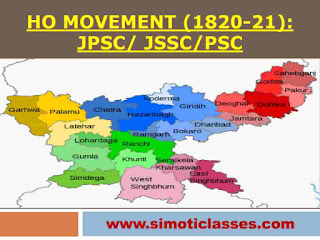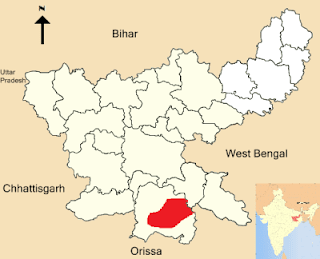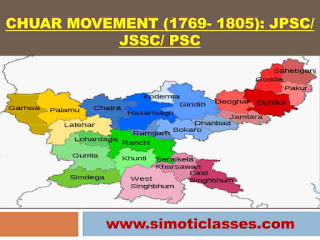Sultanate Jharkhand: Jharkhand History
In general, during the Sultanate period, Muslims entered Jharkhand only while pursuing their enemies or while going to Bengal-Orissa or returning from there. During the Sultanate period, there were sporadic external attacks on Jharkhand. Despite these external invasions, Jharkhand always remained independent during the Sultanate period.
Invasion of Singhbhum by the Raja of Birbhum (West Bengal), the invasion of Hazaribagh (1340 AD) by Malik Baya, the commander of the Sultan of Delhi, Muhammad-bin-Tughlaq and the invasion of Santhal Pargana by Kapilendra Gajapati (1435-70 AD) of Orissa had no lasting effect. Thus, if these sporadic external attacks on Jharkhand are quelled, then the independent power of Jharkhand remained intact throughout the Sultanate period and the kings here continued to rule without any external interference.
In 1202-03 AD, Qutbuddin Aibak's general Bakhtiyar Khilji attacked South Bihar and destroyed and corrupted Udantapuri, Nalanda, and Vikramshila universities and caused heavy bloodshed. As a result, non-Muslim people started taking refuge in Jharkhand to save their lives. In this way, new ethnic elements were incorporated in Jharkhand. During these invasions, Bakhtiyar came to know about the routes to reach Bengal which passed through Jharkhand. He attacked Nadia, the capital of the Sen dynasty ruler of Bengal, Lakshman Sen, passing through Jharkhand in 1204-05 AD.
Ghulam Dynasty Jharkhand (1206-90 AD):
During the time of Sultans Iltutmish (1211-36 AD) and Balban (1265-86 AD) of the Adi Turk slave dynasty, the turmoil in South Bihar had little effect on Jharkhand, because it is reported that Nagavanshi the ruler Harikarna continued to run his kingdom efficiently.
Khilji Dynasty Jharkhand (1290-1320 AD):
Tughlaq Dynasty Jharkhand (1320-1412 AD):
Malik Beya, the commander of the Sultan Muhammad bin Tughlaq (1325-51 AD) of the Tughlaq dynasty, had reached Chai Champa in the Hazaribagh area. Whereas, according to the Santhali source, this invasion took place in 1340 AD under the leadership of Ibrahim Ali. Ibrahim Ali captured the fort of Bigha, as a result, the Santhals of the place escaped with their chieftain for their lives. Muhammad-bin-Tughlaq's successor Firoz Tughlaq (1351-88 AD) defeated Shamsuddin Ilyas Shah of Bengal in a battle for supremacy and conquered a large area in the Satgaon area of Hazaribagh and made Satgaon the capital of his conquered region in (1359-60 AD). But Firoz Tughlaq and his successor could not advance beyond Satgaon, in Chotanagpur Khas, and the Nagvanshi ruler there remained a powerful ruler.
Sayyid Dynasty Jharkhand (1412-51 AD):
Lodhi Dynasty Jharkhand (1451-1526 AD):
The Sultans of the Lodhi dynasty were relatively weak sultans and the influence of the Delhi Sultanate was reduced to a very small area, so they were not in a position to interfere in Jharkhand. The name of the Nagvansh kings who ruled Chotanagpur Khas during the time of Sultans of the Lodi dynasty was Pratap Karna, Chhatra Karna, and Virat Karna.
Jharkhand was saved from the interference of the Lodi Sultans, but it had to face havoc with the Gajapati Dynasty of Orissa, a contemporary dynasty of the Lodi dynasty. Kapilendra Gajapati (1435-70 AD), who was the minister of the last Ganga king of Orissa, established a new dynasty in Orissa, the Gajapati dynasty. Under the leadership of Kapilendra Gajapati, the state of Orissa became a superpower of South-East India. He captured a large part of the Nagvanshi kingdom except for Santhal Pargana and Hazaribagh. Thus, the rule of Kapilendra Gajapati was established over some parts of Jharkhand.
Similarly, Adil Shah-I/ Adil Khan-II (1457-1501 AD) was an extremely powerful ruler of Khandesh. He had amassed immense power. He sent his army to Jharkhand and that is why he became famous as 'Jharkhandi Sultan' = king of the Jungle.
Previous Page:Gupta and post-Gupta period: Jharkhand History- JPSC/ JSSC/ PSC
Next Page:Mughal Era Jharkhand: Jharkhand History- JPSC/ JSSC/ PSC












































